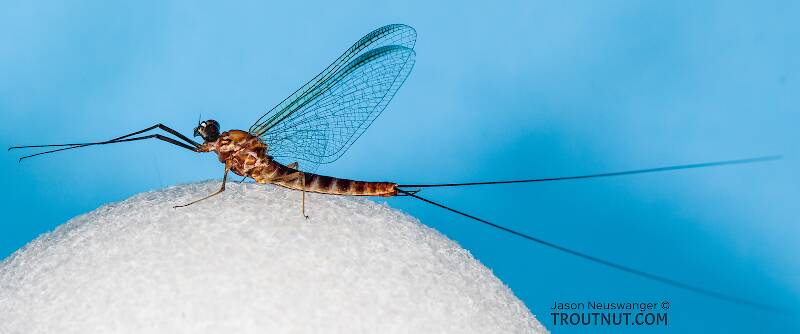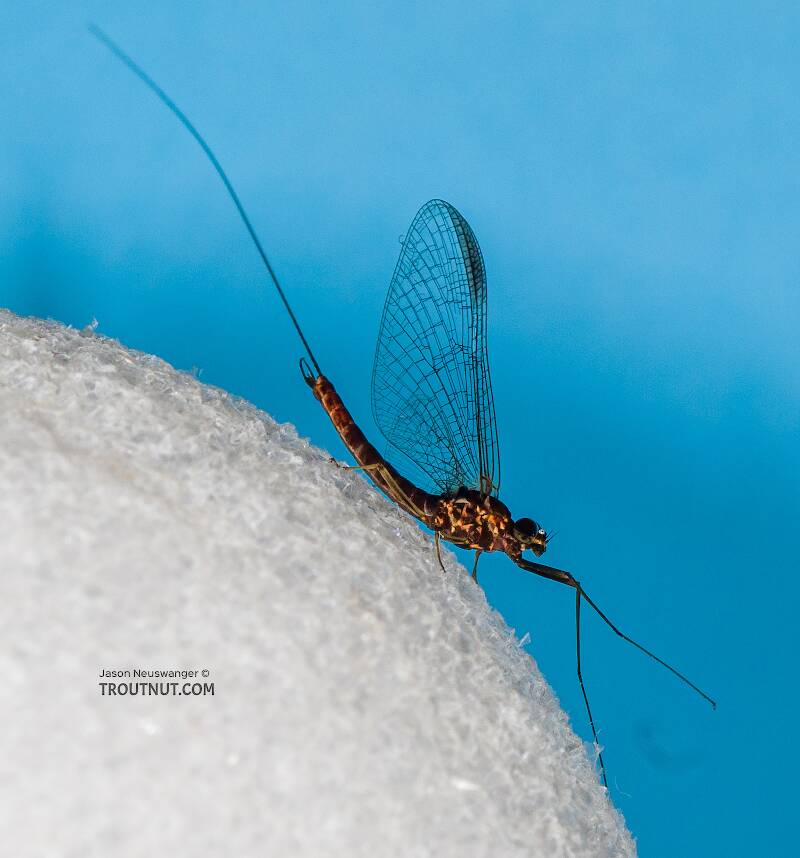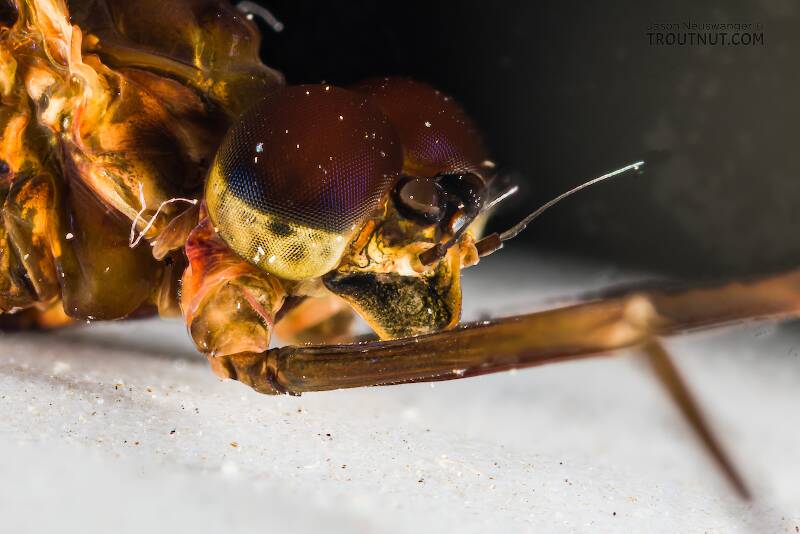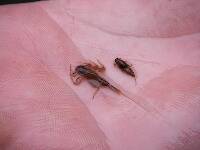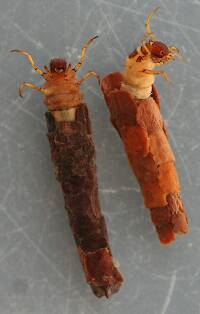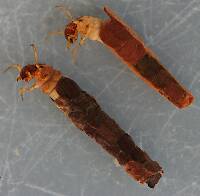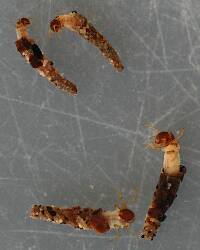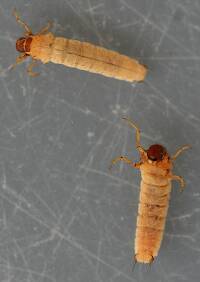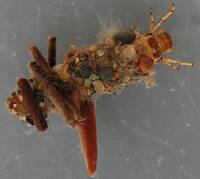
Salmonflies
Pteronarcys californica
The giant Salmonflies of the Western mountains are legendary for their proclivity to elicit consistent dry-fly action and ferocious strikes.
Featured on the forum

This wild-looking little thing completely puzzled me. At first I was thinking beetle or month larva, until I got a look at the pictures on the computer screen. I made a couple of incorrect guesses before entomologist Greg Courtney pointed me in the right direction with Psychodidae. He suggested a possible genus of Thornburghiella, but could not rule out some other members of the tribe Pericomini.

Troutnut is a project started in 2003 by salmonid ecologist Jason "Troutnut" Neuswanger to help anglers and
fly tyers unabashedly embrace the entomological side of the sport. Learn more about Troutnut or
support the project for an enhanced experience here.
This topic is about the Mayfly Genus Rhithrogena
This genus is widespread across the country, but it is only of major importance to anglers in the West.The best hatches come from Rhithrogena morrisoni, Rhithrogena hageni, and Rhithrogena undulata. Even the less common species , Rhithrogena futilis, and Rhithrogena robusta are probably more important than any of their Eastern counterparts.
The East/Midwest species are Rhithrogena jejuna, Rhithrogena manifesta, and Rhithrogena impersonata, which is arguably the most important of a minor group. All of them are widespread and none of them are abundant except in rare locations, mostly in Michigan and Wisconsin.
Example specimens
Entoman on Feb 23, 2013February 23rd, 2013, 10:56 pm EST
It is commonly held that clingers are flattened to make their lives better adapted to faster water. Their teardrop shape is certainly a classic symbol of aero and hydrodynamic perfection, so there must be some connection, right? It seems to me that such ideas show a complete misunderstanding of the hydraulic reality in which they live. Current is negligable even in the fastest a few mm. from the surface of solid objects. In fact, it is actually quite calm. I've observed baetids clinging by their tippy toes to the tops of rocks in fast riffles with no apparent effort, often next to clinger species that look like they're hanging on for dear life. What if clinger nymphs are flattened not to hold their place in fast currents but rather to facilitate movement in their ecological niche of the cramped spaces under and between cobble or crevices in other substrate types?
It is also thought that the gills of some species form ''suction'' to hold them in place. Since suction is a phenomena of vacuum creation in the atmosphere, how are these nymphs accomplishing this underwater? Is it their ultra delicate gills that hold them in place or a firm claw grip? The horizontal sprawl of the legs masks this as the gills stay in place until the legs brake free. Exposed to the air, the gills seem to laminate against the rock, just as crepe paper would if first held underwater before a rock was lifted out into the air from underneath it. However, underwater their gills behave like the crepe, flowing freely. They are performing their function as gills not suction cups. I find it hard to believe they evolved the way some think merely so they can make it more difficult for humans to pluck them from rocks in the atmosphere. How is it these mighty structures that defy our attempts to pry them from the rocks curiously fall off so easily when prodded for inspection a few seconds later in a tray or jostled in a container on the way home?
Even many scientific papers have encouraged these dubious beliefs so it's not just angler myth... And they go unchallenged... Thoughts?
It is also thought that the gills of some species form ''suction'' to hold them in place. Since suction is a phenomena of vacuum creation in the atmosphere, how are these nymphs accomplishing this underwater? Is it their ultra delicate gills that hold them in place or a firm claw grip? The horizontal sprawl of the legs masks this as the gills stay in place until the legs brake free. Exposed to the air, the gills seem to laminate against the rock, just as crepe paper would if first held underwater before a rock was lifted out into the air from underneath it. However, underwater their gills behave like the crepe, flowing freely. They are performing their function as gills not suction cups. I find it hard to believe they evolved the way some think merely so they can make it more difficult for humans to pluck them from rocks in the atmosphere. How is it these mighty structures that defy our attempts to pry them from the rocks curiously fall off so easily when prodded for inspection a few seconds later in a tray or jostled in a container on the way home?
Even many scientific papers have encouraged these dubious beliefs so it's not just angler myth... And they go unchallenged... Thoughts?
"It's not that I find fishing so important, it's just that I find all other endeavors of Man equally unimportant... And not nearly as much fun!" Robert Traver, Anatomy of a Fisherman
Taxon on Feb 24, 2013February 24th, 2013, 12:41 am EST
Hi Kurt-
Okay, I'll bite. Heptageniid nymphs are characterized by a dorso-ventrally compressed bodies, the head of which is generally the widest body region, and with a thorax and abdomen which taper back from it. As for the (fore and aft) ventral gills, I believe that to really be an exception (as opposed to rule) for the family.
Why exactly did they evolve into this particular shape? I would suggest that the shape simply favored their survival in whatever the ecological niche they happened to occupy a veeeeeeeeeeeery long time ago.
Does their body shape continue to favor their survival in their current ecological niche, where they cling to rocks and/or squeeze into tight places? I would think so. Anyway, for better or worse, those are my thoughts on the subject, and now we are both stuck with them. :-)
Okay, I'll bite. Heptageniid nymphs are characterized by a dorso-ventrally compressed bodies, the head of which is generally the widest body region, and with a thorax and abdomen which taper back from it. As for the (fore and aft) ventral gills, I believe that to really be an exception (as opposed to rule) for the family.
Why exactly did they evolve into this particular shape? I would suggest that the shape simply favored their survival in whatever the ecological niche they happened to occupy a veeeeeeeeeeeery long time ago.
Does their body shape continue to favor their survival in their current ecological niche, where they cling to rocks and/or squeeze into tight places? I would think so. Anyway, for better or worse, those are my thoughts on the subject, and now we are both stuck with them. :-)
PaulRoberts on Feb 24, 2013February 24th, 2013, 8:03 am EST
Roger's point that multiple selective forces (over a loooooonng time) play roles in current body configurations is a good one. Certainly clinger types are found in a variety of flow and substrate types. But your specific question has certainly been looked at.
I did read something about this a bit ago. As I understand it, the bottom line was that such inverts are not flattened to live in the viscous layer (which is very thin indeed less than 1mm at best and often measured in angstroms) but instead have body morphologies that serve life in complex flows. Here's some of it:
“A growing larva initially is subject to friction drag, but subsequently experiences mainly pressure drag. This analysis implies that animals might be expected to be more rotund when small and become more streamlined as they grow. Since this does not appear to be true, either the analysis is flawed or body shape is constrained by other agents of selection. … Although each of these laboratory studies has its limitations, collectively they undermine the idea that animals on substrate surfaces routinely find shelter from current within a viscous sublayer.”
“Many invertebrate taxa, including those with flattened shape that has long been viewed as an adaptation to dwell within the viscous sublayer, in fact experience complex flows and relatively high shear. For these organisms, size and shape are important mainly because they influence the ratio of inertial to viscous forces that the organism experiences, and not because of (any need for) sheltering from the current.”
-from “Stream Ecology” by David Allan.

-from Statzner and Holm, 1982.
This diagram shows that flow forces are directed at a certain point of the carapace, and that some turbulence is likely at peripheral, esp downstream areas. The body looks like a hydrofoil (same as an aerofoil) complete with canards to regulate turbulence.
Another use for the flattened shape that I’ve observed (many times) and never heard discussed elsewhere is that flattened species that live in strong currents (some clinger mays and stones) can swim very effectively. They appear to tuck the head using the body, and likely the legs, like a diving plane. They also use their flattened legs as paddles, rapidly fluttering them to swim. They are effective in current and can reach bottom very quickly, almost a vertical descent.
I did read something about this a bit ago. As I understand it, the bottom line was that such inverts are not flattened to live in the viscous layer (which is very thin indeed less than 1mm at best and often measured in angstroms) but instead have body morphologies that serve life in complex flows. Here's some of it:
“A growing larva initially is subject to friction drag, but subsequently experiences mainly pressure drag. This analysis implies that animals might be expected to be more rotund when small and become more streamlined as they grow. Since this does not appear to be true, either the analysis is flawed or body shape is constrained by other agents of selection. … Although each of these laboratory studies has its limitations, collectively they undermine the idea that animals on substrate surfaces routinely find shelter from current within a viscous sublayer.”
“Many invertebrate taxa, including those with flattened shape that has long been viewed as an adaptation to dwell within the viscous sublayer, in fact experience complex flows and relatively high shear. For these organisms, size and shape are important mainly because they influence the ratio of inertial to viscous forces that the organism experiences, and not because of (any need for) sheltering from the current.”
-from “Stream Ecology” by David Allan.

-from Statzner and Holm, 1982.
This diagram shows that flow forces are directed at a certain point of the carapace, and that some turbulence is likely at peripheral, esp downstream areas. The body looks like a hydrofoil (same as an aerofoil) complete with canards to regulate turbulence.
Another use for the flattened shape that I’ve observed (many times) and never heard discussed elsewhere is that flattened species that live in strong currents (some clinger mays and stones) can swim very effectively. They appear to tuck the head using the body, and likely the legs, like a diving plane. They also use their flattened legs as paddles, rapidly fluttering them to swim. They are effective in current and can reach bottom very quickly, almost a vertical descent.
Entoman on Feb 24, 2013February 24th, 2013, 10:35 am EST
Okay, I'll bite.
Thanks, Taxon. Just trying to stimulate discussion between flies. My vice isn't much of a conversationalist.:)
As for the (fore and aft) ventral gills, I believe that to really be an exception (as opposed to rule) for the family.
As regards species counts, yes. But in terms of sheer numbers of critters, none come closer than a tiny fraction to the "suction" gilled Epeorus and Rhithrogena genera in the western states. Regardless, this point begs the question.
Another use for the flattened shape that I’ve observed (many times) and never heard discussed elsewhere is that flattened species that live in strong currents (some clinger mays and stones) can swim very effectively. They appear to tuck the head using the body, and likely the legs, like a diving plane. They also use their flattened legs as paddles, rapidly fluttering them to swim. They are effective in current and can reach bottom very quickly, almost a vertical descent.
I've noticed the same ability, Paul. The quick vertical decent would be vital in reestablishing a foothold (gill hold?) quickly in the event of flood stage flows that frequently dislodge whole sections of the substrata, lose their footing while migrating to their emergence sites, or are dislodged for other reasons.
It seems to me that you have hit on what may be the second part for the real purpose of heptageniid conformation. In other words, how would nature design a body who's primary purpose is to access tight spaces in an aquatic invironment, be able to scuttle around quickly to avoid predation, yet meet a secondary purpose of being able to quickly regain the bottom during the common events of stream bed dislocation or behavioral drift/hatching requirements? Their shape is so efficient that even with feeble swimming effort the current well force them down rather quickly, similar to the effect of an airplane elevator. I would argue that it's morphology has little to do with the adaptive needs of hanging onto the surface of cobble exposed to currents. The laminar flow effect diagram misses the point in my opinion. Not that the flows as diagrammed aren't accurate, but rather they are superfluous as they measure gradations from not moving to barely moving. Again, baetids hold on the tops of rocks well elevated on their claws with little apparent effort, even in the swiftest riffles.
"It's not that I find fishing so important, it's just that I find all other endeavors of Man equally unimportant... And not nearly as much fun!" Robert Traver, Anatomy of a Fisherman
PaulRoberts on Feb 24, 2013February 24th, 2013, 11:05 am EST
Baetids are also hydrofoils, but fusiform in shape -fishlike. There's more than one way to skin a cat.
Claws are definitely important too, for all fast water dwellers.
Claws are definitely important too, for all fast water dwellers.
Entoman on Feb 24, 2013February 24th, 2013, 11:14 am EST
Agreed, but their legs in the vertical posture would negate that, would it not? Perhaps their shape has more to do with swimming in open currents (with their legs swept back against their bodies) than maintaining grip in the soft flows adjacent to the substrate?
BTW - What's your experience/opinion with/of the "suction gill" theory? Fact or Fiction...?:)
BTW - What's your experience/opinion with/of the "suction gill" theory? Fact or Fiction...?:)
"It's not that I find fishing so important, it's just that I find all other endeavors of Man equally unimportant... And not nearly as much fun!" Robert Traver, Anatomy of a Fisherman
Entoman on Feb 24, 2013February 24th, 2013, 11:20 am EST
You mean about the claws, Mack? If so yes, in a roundabout way.
"It's not that I find fishing so important, it's just that I find all other endeavors of Man equally unimportant... And not nearly as much fun!" Robert Traver, Anatomy of a Fisherman
PaulRoberts on Feb 24, 2013February 24th, 2013, 11:45 am EST
BTW - What's your experience/opinion with/of the "suction gill" theory? Fact or Fiction...?:)
None. Sounds like a good idea. But I'm not aware of any good literature.
Entoman on Feb 24, 2013February 24th, 2013, 12:03 pm EST
Mack - Sorry, I didn't pick up on that in your post.
Paul - Yeah, same with me. I don't know of any papers that directly address this issue either, though there are many that simply mention the concept in passing as a given. I also have no anecdotal experience with it (that I'm aware of), in spite of picking countless Western March Browns off of rocks over the years. I always assumed because of their flat bodies and grippy strong legs that they were just hard to get a hold of. Don't know about it being a good idea, though.:)
Paul - Yeah, same with me. I don't know of any papers that directly address this issue either, though there are many that simply mention the concept in passing as a given. I also have no anecdotal experience with it (that I'm aware of), in spite of picking countless Western March Browns off of rocks over the years. I always assumed because of their flat bodies and grippy strong legs that they were just hard to get a hold of. Don't know about it being a good idea, though.:)
"It's not that I find fishing so important, it's just that I find all other endeavors of Man equally unimportant... And not nearly as much fun!" Robert Traver, Anatomy of a Fisherman
Troutnut on Sep 26, 2015September 26th, 2015, 4:26 pm EDT
I just noticed this really interesting discussion from a couple years ago and am bumping it up to reply (although it looks like some other posts already made these points).
A large portion of the invertebrate drift in most rivers consists of bugs drifting by accident. This increases substantially at higher water velocities, which probably means the insects are affected by the hydraulic forces on the rocks. Velocity at the bottom is lower than elsewhere, but it's not negligible, and it can be turbulent. I think the conventional wisdom is probably right with regard to adaptations like flattened bodies and suction-cup-like gills giving insects an advantage in this environment. They may not need this advantage all the time, but it comes in handy often enough that it exerted selective pressure on these species over many generations.
A large portion of the invertebrate drift in most rivers consists of bugs drifting by accident. This increases substantially at higher water velocities, which probably means the insects are affected by the hydraulic forces on the rocks. Velocity at the bottom is lower than elsewhere, but it's not negligible, and it can be turbulent. I think the conventional wisdom is probably right with regard to adaptations like flattened bodies and suction-cup-like gills giving insects an advantage in this environment. They may not need this advantage all the time, but it comes in handy often enough that it exerted selective pressure on these species over many generations.
Jason Neuswanger, Ph.D.
Troutnut and salmonid ecologist
Troutnut and salmonid ecologist
PaulRoberts on Sep 27, 2015September 27th, 2015, 4:45 am EDT
Thanks for bringing this back up, Jason. And for your comments.
Steamntrout
Posts: 3
Posts: 3
Steamntrout on Jun 14, 2017June 14th, 2017, 5:46 am EDT
Reading your description and analysis is truly enlightening, I would have to agree with your analysis.
Quick Reply
Related Discussions
Topic
Replies
Last Reply
Re: Cahills hatching characteristics and swimming ability
In Stenacron interpunctatum Mayfly Nymph by Chadwick
In Stenacron interpunctatum Mayfly Nymph by Chadwick
1
Jul 2, 2009
by GONZO
by GONZO
34
Mar 27, 2013
by Feathers5
by Feathers5


